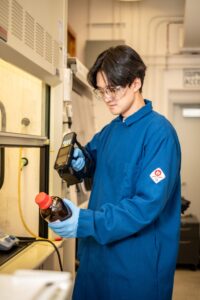
Beginning earlier this year, chemical owners at LBNL began transitioning to RFID technology to maintain their chemical inventories in the Chemical Management System (CMS). The process includes a wall-to-wall chemical inventory reconciliation to ensure all containers are accounted for accurately in CMS and have been RFID tagged. While this process requires some effort up front, labs are discovering that the time and energy is well spent – chemical owners are seeing first-hand the efficiency of the new technology and the increased accuracy of their chemical inventories. Having accurate chemical inventories Lab-wide enables researchers to more easily find chemical containers (either in their own lab, or someone else’s).
For the benefit of those chemical owners yet to undergo the transition to RFID barcodes, Daewon Lee of Haimei Zheng’s lab in the Materials Sciences Division offers the following observations on his lab’s experience of the process.
“Excited… and concerned”
Daewon reports: “When I was first told about the new RFID system for managing our chemical inventory, I was excited – and concerned. I was excited about an easier way to manage all the chemicals in our lab (sometimes chemicals move somewhere, suddenly), and at the same time concerned about the transition from the old barcode system. The transition was actually smoother than I anticipated, thanks to the EHS staff’s tremendous efforts. Their preparations made the reconciliation manageable – they affixed RFID tags to most of our group’s chemicals, and properly updated any discrepancies in our chemical inventory. We also found that the one to two day delay in receiving chemicals is reasonable and doesn’t impact our work.”
“RFID tags are so efficient!”
Daewon adds: “Taking advantage of RF signals, inventory scanning with RFID tags was super-fast compared to the old way of checking barcodes. The experience with the RFID reader made me realize why we must move to this new system from the old one.”
Takeaways for other labs
Daewon offers these takeaways for labs transitioning to RFID:
- Training is essential and cheat-sheets are helpful: “Training on using the RFID system – including how to properly affix RFID tags and dispose of empty bottles – especially for new lab members, ensures everyone is on the same page. We also found it helpful to post cheat-sheets in our lab spaces on the RFID system and general chemical management – from ordering to disposal.”
- Regular checks: “Even with the new RFID system, it is essential to double-check for chemical inventory-related issues, especially when you order new chemicals and have time-sensitive chemicals in your lab spaces, which require regular testing and recording of the results in the CMS system. It’s especially important to perform regular checks when different lab members are performing the functions of buying and receiving chemicals.”
In conclusion
Daewon sums up his lab’s experience with adopting the new RFID technology and inventory reconciliation process: “Overall, I think the transition to the RFID-based chemical inventory system has significantly benefited our lab. It has made our processes more efficient, reduced errors, and enhanced safety and compliance. While the initial setup and adaptation required effort, the long-term benefits have been worth it.”

